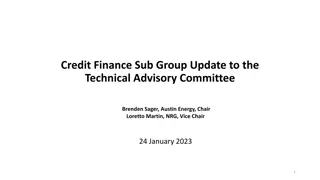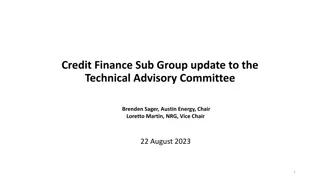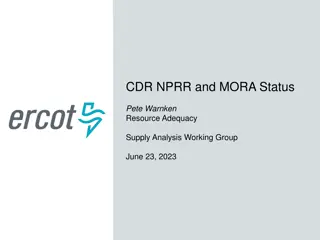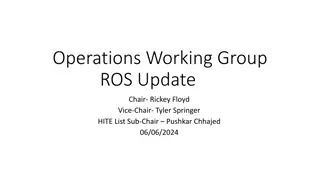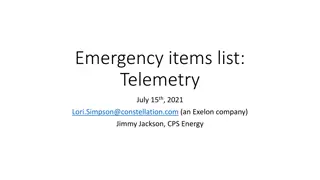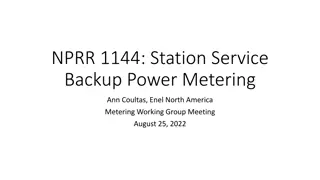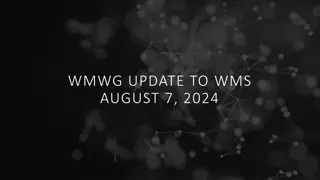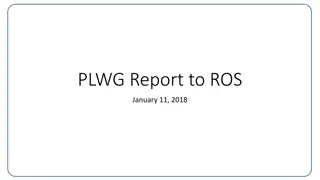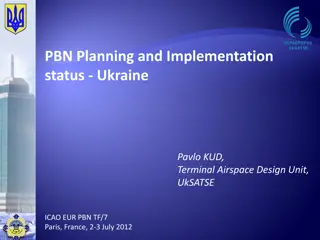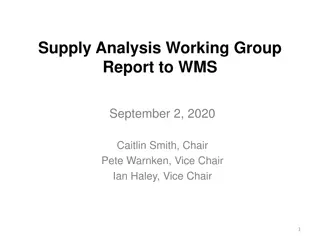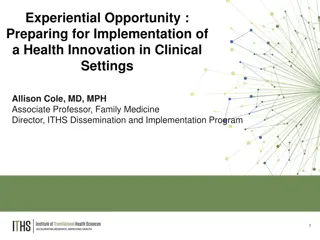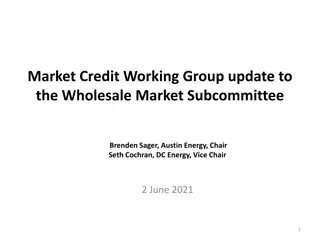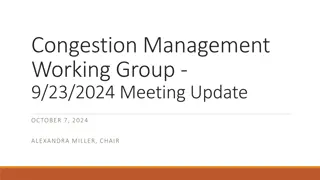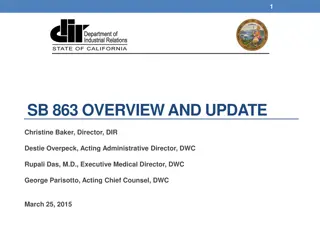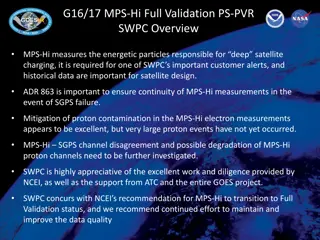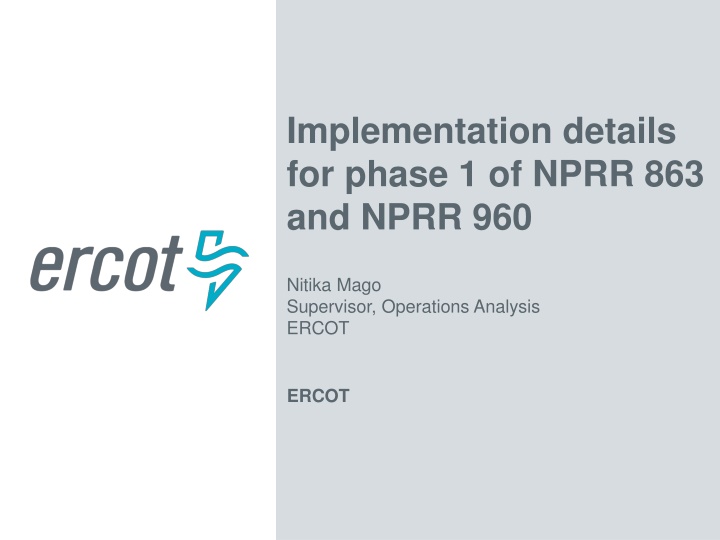
ERCOT Fast Frequency Response Implementation Details NPRR 863 and NPRR 960
"Learn about the scope and implementation details for Phase 1 of NPRR 863 and NPRR 960 in ERCOT focusing on Fast Frequency Response (FFR) deployment and resources' responsibilities. Battery energy storage and Controllable Load Resources are key players in this phase effective from March 1, 2020. Find out more about the requirements and protocols for providing FFR in the ERCOT system."
Uploaded on | 5 Views
Download Presentation

Please find below an Image/Link to download the presentation.
The content on the website is provided AS IS for your information and personal use only. It may not be sold, licensed, or shared on other websites without obtaining consent from the author. If you encounter any issues during the download, it is possible that the publisher has removed the file from their server.
You are allowed to download the files provided on this website for personal or commercial use, subject to the condition that they are used lawfully. All files are the property of their respective owners.
The content on the website is provided AS IS for your information and personal use only. It may not be sold, licensed, or shared on other websites without obtaining consent from the author.
E N D
Presentation Transcript
Implementation details for phase 1 of NPRR 863 and NPRR 960 Nitika Mago Supervisor, Operations Analysis ERCOT ERCOT
Implementation Scope for Phase 1 Fast Frequency Response (FFR) The automatic self-deployment and provision by a Resource of their obligated response within 15 cycles after frequency meets or drops below a preset threshold (59.85 Hz) or a deployment is response to an ERCOT Verbal Dispatch Instruction (VDI) within 10 minutes. Resources capable of automatically self-deploying and providing their full Ancillary Service Resource Responsibility within 15 cycles after frequency meets or drops below a preset threshold and sustaining a full response for at least 15 minutes may provide Responsive Response Service (RRS). A Resource providing RRS as FFR that is deployed shall not recall its capacity until system frequency is greater than 59.98 Hz. Once recalled, a Resource providing RRS as FFR must restore their full RRS Ancillary Service Resource Responsibility within 15 minutes after cessation of deployment or as otherwise directed by ERCOT. Phase 1 of NPRR863/NPRR960* (Phase 1) primarily focuses on implementing Fast Frequency Response (FFR) as a subset of Responsive Reserve Service (RRS)**. Phase 1 is expected to be effective on March 1, 2020. In Phase 1, Battery energy storage will be the only resource able to qualify to provide FFR. FFR from non-Controllable Load Resource will be supported in the next phase the 10-minute ramp component of RRS will continue to exist. Generation Resource providing RRS will continue to be expected to release capacity ( HASL release ) to SCED once an RRS deployment is received. RRS limit for all Generation Resources will be based on methodology outlined in OBDR Methodology to Calculate Responsive Reserve (RRS) Service Limits. A limit of 450 MW will be applied on Resources providing FFR. *Documents associated with NPRR863 and NPRR960 can be found on the ERCOT website. ** Appendix contains a full list of protocols that will be un-gray boxed. PUBLIC 2
FFR Deployment QSE Level Resources providing FFR must respond to a frequency event autonomously when the frequency trigger criteria is met. These resources must be capable of sustaining full response for at least 15 minutes or till ERCOT recalls the deployment, whichever occurs first. A new ICCP tag* will be created to send QSE specific RRS MWs requests/deployments to FFR Resources. QSE Specific FFR RRS MWs request/deployment will be non-zero when frequency reaches 59.85 Hz and zero when frequency reaches 59.98 Hz. QSE FFR Request/Deployment (MW) Frequency (Hz) 12 60.08 11 60.04 10 60.00 FFR Deployment (MW) 9 59.96 8 59.92 Frequency (Hz) 7 59.88 6 59.84 5 59.80 4 59.76 3 59.72 2 59.68 1 59.64 0 59.60 1 2 3 4 5 6 7 8 9 10 11 12 13 14 15 16 17 18 19 20 21 22 23 24 25 26 27 28 29 30 31 32 33 34 35 36 37 38 39 40 41 42 43 44 45 46 47 48 49 50 51 52 53 54 55 56 57 58 59 60 61 62 63 64 65 66 67 68 69 70 71 72 73 Time 74 75 76 77 78 79 80 81 82 83 84 85 86 87 88 89 90 91 92 93 94 95 96 97 98 99 100 101 102 103 104 105 106 107 108 109 110 111 112 113 114 115 116 117 118 119 120 121 122 123 124 125 126 127 128 129 130 131 132 133 134 135 136 137 138 139 140 141 142 143 144 145 146 147 148 149 150 151 *Contact ERCOT s EMMS Production Support personnel for details on this tag. 3 PUBLIC 3
FFR Deployment Resource Level A battery energy storage Resource providing FFR in Real Time must use Resource Status (RST) = 21 (i.e. ONFFRRRS) on the Generation Resource portion of combo- model. ERCOT systems are setup to provide a Resource providing FFR SCED Base Points (BPs) and Updated Desired base Point (UDBP) subject to the Resource's dispatch limits, which are calculated using the Resource's telemetered inputs (High Sustained Limit (HSL), Low Sustained Limit (LSL), Responsive Reserve Responsibility (RRRS), Responsive Reserve Schedule (RRSC), etc.) and the submitted offer curves. Resource providing FFR is expected to respond autonomously to frequency. Upon getting triggered, such Resource is expected to set its RRSC = 0; this allows SCED appropriately set the Resource s BP (and thus UDBP). When FFR is recalled, it is recommended that the Resource providing FFR follow its UDBP to ramp down to 0 MW. Upon completion of an FFR deployment a Resource providing FFR is expected to reset RRRS/RRSC according to the Resource s capability as soon as practicable but no later than 15 minutes (or the QSE is expected to move the RRS obligation to a different Resource). 4 PUBLIC 4
Telemetry setup Example 1 Example below provides a high level outline of telemetry on the Generation Resource portion of combo-model when this Resource providing FFR is deployed. FFR-Deployed Output UDBP RRSC* HDL/HASL HSL 12 12 FFR Deployed UDBP ramps to BP FFR Recalled System Lambda < Resource 10 10 8 8 RRS restored immediately. HSL stay at pre-event level. MW = HSL, RRSC = 0, HDL/HASL = HSL MW MW 6 6 4 4 UDBP & MW ramps to 0. 2 2 0 0 1 2 3 4 5 6 7 8 9 10 11 Time Sequence Note that this example is intended to represent of sequence of events and is not indicative of time/duration. *For a Resource that is providing FFR in Real Time ERCOT systems shall validate & limit Ancillary Service Responsibility and Ancillary Service Schedule for RRS to be less than or equal to its respective FFR Qualified MWs. 5 PUBLIC 5
Telemetry setup Example 2 Example below provides a high level outline of telemetry on the Generation Resource portion of combo-model when this Resource providing FFR is deployed. FFR-Deployed Output UDBP RRSC* HDL/HASL HSL 12 12 UDBP ramps to BP FFR Recalled FFR Deployed System Lambda < Resource Offer 10 10 UDBP & MW ramp to 0. 8 8 RRS restored. HSL returns to pre-event level. MW MW = HSL, RRSC = 0, HDL/HASL = HSL MW 6 6 4 4 HSL to 0, Indicates the need to charge 2 2 0 0 1 2 3 4 5 6 7 8 9 10 11 12 13 14 Time Sequence Note that this example is intended to represent of sequence of events and is not indicative of time/duration. 6 PUBLIC 6
FFR Deployment Performance For an FFR deployment event triggered by an under-frequency event (frequency at or below 59.85 Hz), ERCOT will reach out to Resources providing FFR to obtain high speed data to verify that The total time from the time frequency first decays to a value low enough to initiate action up to the time when full Ancillary Service Resource Responsibility for RRS is delivered should be no more than 15 cycles, including all relay and breaker operating times; The Resource deployed 95% to 110% of its Ancillary Service Resource Responsibility in 15 cycles after the frequency reached 59.85 Hz; The Resource sustained 95% to 110% of its Ancillary Service Resource Responsibility for the duration of the sustained response period, defined as 15 minutes or until the time of recall instruction from ERCOT, whichever occurred first; The Resource restored its capability to provide its Ancillary Service Resource Responsibility within 15 minutes from the end of the deployment period subject to grid conditions following the recall instruction. This is an ad-hoc analysis and will be conducted in close coordination with the Resource. 7 PUBLIC 7
FFR Qualification ERCOT is currently accepting requests from Resources interested to provide FFR. FFR qualification test will be two pronged test a self test that demonstrates the Resource s ability to deploy within 15 cycles of when the frequency trigger is met and to sustain response for at lease 15 minutes; and a coordinated test that demonstrates the Resource s ability to change Ancillary Service Schedule for RRS telemetry in response to an ERCOT deployment. ERCOT s Registration systems will track the capacity a Resource providing FFR is qualified to provide. ERCOT systems will limit RRS Offers/Awards from a Resource seeking to provide FFR in Day Ahead Market and Ancillary Service Responsibility and Ancillary Service Schedule for RRS from Resource providing FFR in Real Time per its respective FFR Qualified MWs. 8 PUBLIC 8
RRS Limits In Phase 1, the full amount of RRS awarded to or self-arranged from an On-Line Generation Resource will be dependent upon the verified droop characteristics of the Resource. ERCOT shall use the methodology outlined in Other Binding Document, Procedure for Calculating Responsive Reserve (RRS) Limits for Individual Resources calculate and update, using the methodology described in the Nodal Operating Guide, to compute a maximum percentage (%) of RRS and a maximum MW amount of RRS for each Generation Resource. This new certified report, Responsive Reserve Limits for Generation Resources (EMIL ID NOG2-312-M , Report ID 19236) will be posted on ERCOT s Market Information System (MIS) | Grid | Generation page. A report will be posted concurrently on the day Phase 1 becomes effective. In this report the RRS limit for all thermal Generation Resources will be set to 20%. The RRS % Limit for non-thermal Generation Resource will be the limit established during RRS qualification process. A default value of 20% shall be used in all other cases. The timeline established in Section 6 will be followed for all subsequent RRS Limit report postings. 9 PUBLIC 9
Public Dashboard, MIS, Et. all Two new data fields will be included in the System Ancillary Service Capacity Monitor display on ercot.com and in the QSE Ancillary Services Capacity Monitor report (EMIL ID: NP8-143-CD, Report Type ID: 11025) on ERCOT's Market Information System (MIS). RRS Capacity from Resources capable of Fast Frequency Response (FFR) Ancillary Service Resource Responsibility for RRS Resources capable of FFR The Responsive Reserve Performance Report for Generators and CLRs report (EMID ID: NP8-543-M, Report Type ID: 13033) on ERCOT s MIS will be updated to include response from Resources providing FFR in Real Time. The following Business Practice Manuals will be updated to capture phase 1 FFR related expectations. Current Operating Plan Practices By QSE ERCOT and QSE Operations Practices During The Operating Hour 10 PUBLIC 10
Acronyms BP - Base Point FFR - Fast Frequency Response HASL - High Ancillary Service Limit HDL - High Dispatch Limit HSL - High Sustained Limit ICCP - Inter-Control Center Protocol LSL - Low Sustained Limit QSE - Qualified Scheduling Entity RRRS - Responsive Reserve Responsibility RRS - Responsive Reserve RRSC - Responsive Reserve Schedule RST - Resource Status SCED - Security Constrained Economic Dispatch UDBP - Updated Desired Base Point 11 PUBLIC 11
APPENDIX PUBLIC 12 12
Protocol Sections to be Un-Gray Boxed in Phase 1 The following outlines Nodal Protocol sections that will be un-gray boxed in Phase 1. In cases where only a portion of a Section is being un-gray boxed, specific references have been included in parenthesis. 2.1, Definitions (Fast Frequency Response) 3.8.4, Hydro Generation Resources (3.8.4, Generation Resources Operating in Synchronous Condenser Fast Response) 3.9.1, Current Operating Plan (COP) Criteria (3.9.1 (5)(b)(i)(K); 3.9.1 (5)(b)(i)(Q)) 3.16, Standards for Determining Ancillary Service Quantities (3.16 (2)(b)-(e); 3.16 (3); 3.16 (5)*; 3.16 (6)*; 3.16 (7)) 3.18, Resource Limits in Providing Ancillary Service (3.18 (3)) 4.4.7.1, Self-Arranged Ancillary Service Quantities (4.4.7.1 (9)(c)*) 4.4.7.1.1, Negative Self-Arranged Ancillary Service Quantities (4.4.7.1.1 (3)*) 4.4.7.3, Ancillary Service Trades (4.4.7.3(7)) 4.6.4.1.3, Responsive Reserve Service Payment 4.6.4.2.3, Responsive Reserve Service Charge 6.5.7.5, Ancillary Services Capacity Monitor (6.5.7.5 (1)(a)(iv); 6.5.7.5 (1)(b)(iv); 6.5.7.5 (1)(m) - PRC7) 6.5.7.6.2.2, Deployment of Responsive Reserve Service (6.5.7.6.2.2 (2)(a)-(b); 6.5.7.6.2.2(13)-(16)) 6.5.9.4.1, General Procedures Prior to EEA Operations (6.5.9.4.1(1)(a), 6.5.9.4.1(1)(d)*) 8.1.1.1, Ancillary Service Qualification and Testing (8.1.1.1 (10)-(11)) 8.1.1.3.2, Responsive Reserve Capacity Monitoring Criteria 8.1.1.4.2, Responsive Reserve Energy Deployment Criteria (8.1.1.4.2 (1)(b)-(c); 8.1.1.4.2(2)-(7)) 8.5.2, Primary Frequency Response Measurements 8.5.2.1, ERCOT Required Primary Frequency Response 9.2.3, DAM Settlement Charge Types (9.2.3 (1)(h); 9.2.3(1)(l)) *As written in NPRR 960. 13 PUBLIC 13
Nodal Operating Guide Sections to be Un-Gray Boxed in Phase 1 The following outlines Nodal Operating Guide sections that will be un-gray boxed in Phase 1. In cases where only a portion of a Section is being un-gray boxed, specific references have been included in parenthesis. 1.4, Definitions (Automatic Generation Control) 2.2.4.1, Maintenance and Verification 2.2.4.2, Regulation Provider Loss of AGC 2.3, Ancillary Services 2.3.1.2, Additional Operational Details for Responsive Reserve Providers (2.3.1.2 (1); 2.3.1.2(3)-(5); 2.3.1.2 (8)(b); 2.3.1.2 (8)(d); 2.3.1.2 (9)-(11)) 2.3.1.2.1, Limit on Generation Resources and Controllable Load Resources Providing RRS (2.3.1.2.1(1)-(4)) 4.5.2, Operating Procedures(4.5.2 (3)(f)) (4.5.2 (3)(f)) 8, Attachment F 14 PUBLIC 14
Other Binding Documents to be Un-Gray Boxed in Phase 1 The following outlines Other Binding Documents that will be un-gray boxed in Phase 1. Methodology for Determining Minimum Ancillary Service Requirements Procedure for Calculating Responsive Reserve (RRS) Limits for Individual Resources 15 PUBLIC 15
FFR Qualification Details - Self Test The following steps should be followed when conducting a Self Test for FFR: 1. Ancillary Service Resource Responsibility must be set equal to MW capacity for which the Resource seeks qualification for FFR. 2. The test is performed by adding a frequency offset such that frequency decays low enough to initiate response from the Resource. Note that the initiation setting of the under-frequency relay or similar trigger mechanism shall not be any lower than 59.85 Hz; 3. The test starts at time t0 when the frequency exceeds the initiation setting & initiates a response from the Resource. The following signals should be recorded with a resolution of no less than 32 samples per second (a) Frequency (Hz) (b) MW Output (MW) 4. Upon completion send recorded data with at least 15 minutes of data to ERCOT. The following criteria will be used to evaluate Self Test for FFR: The total time from the time frequency first decays to a value low enough to initiate action up to the time when full Ancillary Service Resource Responsibility for RRS is delivered should be no more than 15 cycles, including all relay and breaker operating times; The resource must demonstrate its ability to sustain the scheduled level of deployment for at least 15 minutes at a minimum level of 95% but not more than a maximum level of 110% of the MW capacity for which the Resource seeks qualification for FFR. Note ERCOT systems will track the capacity a Resource providing FFR is qualified to provide. 16 PUBLIC 16


